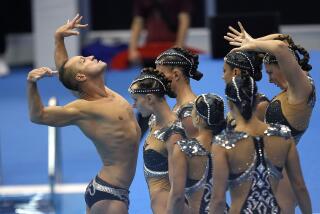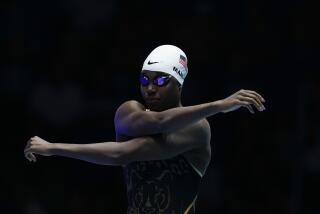Surfer King, Swimmer Extraordinaire, Lifesaving Hero
Show me a hero and I’ll write you a tragedy.
--F. Scott Fitzgerald
*
All the wannabes who watch the surfing scene and all the hodaddies who actually hit the water are following in the wet footsteps of George Douglas Freeth Jr., the Anglo Hawaiian phenomenon who brought surfing to Southern California.
More than 80 years after his death, many of Southern California’s normally irreverent surfers and lifeguards still regard Freeth as a god. Billed by promoters as “the man who walked on water,” he was the first person to hang 10--walk the nose of the surfboard. He also was the region’s first official lifeguard.
He popularized the Australian crawl, invented the torpedo-shaped rescue buoy and introduced water polo to the West Coast--all legacies that endure to this day.
He also won a congressional medal for heroism.
Most important, he trained a generation of lifeguards, saved hundreds of lives himself and set a standard of athletic excellence that others have tried to emulate ever since.
Freeth was born on the island of Oahu in 1883 to a prominent Hawaiian family.
The son of an English sea captain and a well-heeled half-Hawaiian, half-English mother, he took to the ocean at an early age to swim, high-dive and surf. He revived the once-banned Hawaiian sport of surfing, which New England missionaries had deplored and then outlawed because of its “immodesty and idleness.”
His surfing and swimming prowess caught the attention of several writers, including novelist Jack London, who immortalized him in an essay on sports as “a Mercury--a brown Mercury. His heels are winged, and in them is the swiftness of the sea.”
In July 1907, bearing a letter of introduction from the author, Freeth, 23, left Hawaii for the first time and sailed to the mainland. An official member of the Hawaii promotion committee, he touted tourism to the islands and demonstrated surfing in California.
His timing could not have been better. Two months before Freeth’s arrival, Venice and Redondo Beach were on their way to becoming dream beach communities. Pacific Electric Railway developer Henry Huntington ran a trolley to the marshland he owned and was busy promoting Redondo Beach, while his friend and sometimes rival, Abbot Kinney, had already built a utopian residential community and theme park a dozen miles away in Venice.
To lure buyers and tap into the fitness craze sweeping the nation, both developers built indoor saltwater plunges.
But out on the ocean, even experienced swimmers were drowning at alarming rates. Potential buyers afraid for their children’s safety were reluctant to buy near the beach, wrote lifeguard and history professor Arthur C. Verge in a California History article, “George Freeth: King of the Surfers and California’s Forgotten Hero.”
To help Huntington and Kinney in their sales job, 28 men formed the volunteer Venice Lifesaving Crew. But after one of them drowned in front of his stunned crew mates, it triggered fund-raising for training and equipment for volunteer lifeguards.
Southern Californian beachgoers first spotted Freeth gliding across the waves off Venice on his 200-pound, 8-foot-long solid wood surfboard. He quickly made newspaper headlines throughout the region.
Kinney and Huntington were soon knocking at his door, and Freeth began dividing his time between the two resorts, where he gave crowd-pleasing surfing performances. But his bread-and-butter came from teaching swimming and diving at the Venice and Redondo pools.
Freeth’s chief concern was water safety. In his free time, he trained young swimmers to become lifeguards, showing them how to use rip currents to help speed them out to victims. The technique, which is still used today, was responsible for saving hundreds of lives in the first five years it was used, according to Verge.
On Dec. 16, 1908, a sudden squall blew in from the Pacific and slammed into Santa Monica Bay. Freeth was standing on the Venice Pier as huge waves broke in front of him, and he watched Japanese fishing boats bob in the bay. When one began to sink, Freeth broke into a run, hurled himself into an oncoming wave and swam through the gale to reach the vessel.
Within a matter of moments, he would bring seven fishermen safely to shore. Freeth held on to the men, one or sometimes two at a time, barely cresting the first wave as the water pitched and rolled toward shore. Again and again, he plunged into the frigid surf as thousands of spectators watched.
While his fellow lifesavers tried for more than an hour to launch the lifeboat in repeated avalanches of water, Freeth dived in one last time to keep four more fishermen afloat until the lifeboat finally rescued them. No one drowned.
“Girls crowded around just to pat his tanned shoulders and smile at him,” reported the Los Angeles Times.
The rescued fishermen gave Freeth a gold watch, donated money to the lifeguard fund and changed the name of their village near Pacific Palisades from Maikura to Port Freeth. The village was destroyed by fire five years later.
Less than two years after the heroic rescue, Freeth received the Congressional Gold Medal, the nation’s highest civilian honor for bravery. It recognized his lifesaving techniques, which were being adopted throughout the nation.
Freeth continued to pioneer modern lifeguard procedures. He preached the importance of quick action, and showed that boats and rowing crews took too long to reach victims. He warned swimmers of potential dangers and invented the red torpedo-shaped safety “can,” a flotation device that is now standard issue for ocean lifeguards the world over.
Never charging a dime for his ideas or mentoring, he turned pupils into well-rounded athletes, teaching children and adults confidence and fearlessness of the water.
During the off-season, he conditioned volunteer lifeguards by organizing the West Coast’s first water polo teams. In 1909, he began to teach high-diving from the rafters of Huntington’s new plunge. The facility was equipped with a phone so that if someone was at risk of drowning outside at the beach, Freeth could be summoned.
Redondo Beach city fathers pitched in and bought him a motorcycle with a sidecar to patrol the shoreline and paid him $25 a month as a special lifeguard.
Without realizing it, that stipend ruined his hopes of competing in the Olympics. It made him ineligible for the 1912 Games. By the rules of amateurism, Freeth was a professional with a paying job.
Although Freeth never made it to Stockholm that year, his good friend Duke Kahanamoku did and won the 100-meter freestyle, for the first of five Olympic swimming medals in his career. Later, under Freeth’s guidance, Kahanamoku would improve his freestyle stroke and turns in the pool at the Los Angeles Athletic Club, where Freeth coached the club’s swim team. Kahanamoku called Freeth “the world’s greatest diver.”
In 1915, Freeth headed to San Diego, moving from seasonal job to seasonal job. Three years later, when the military began training a million recruits for World War I, Ocean Beach overflowed with thousands of swimmers. Without professional lifeguards, 13 men drowned the first week of May 1918.
The resort owners, fearing financial ruin, hired Freeth as a lifeguard. That summer, large crowds flocked to the beach to watch Freeth turn somersaults in the air from his surfboard, then regain his balance and surf on in to the beach. Not a single swimmer drowned on his watch.
In 1919, at the age of 35, this exceptionally fit man became one of the millions of young and healthy people who died in the brutal Spanish influenza epidemic that wiped out 20 million people worldwide.
The pier at Redondo Beach has a sculpture of Freeth’s face.
“Freeth was never a man of money; instead, he was a man of deeds,” Verge wrote.
What he had in the way of worldly goods when he died could fit in the same small suitcase that he had brought to California a dozen years earlier.
More to Read
Sign up for The Wild
We’ll help you find the best places to hike, bike and run, as well as the perfect silent spots for meditation and yoga.
You may occasionally receive promotional content from the Los Angeles Times.






